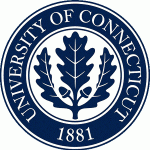
This past spring, Prof. Delia Furtado gave the Georgescu-Rogen Lecture at Sewanee: The University of the South while visiting with UConn PhDs, Huarui Jing and Tao Song.
Sewanee is among the nation’s top national liberal arts colleges and is consistently ranked as one of the top five in the South. While Professor Furtado enjoyed walking around the beautiful campus, often spotting students and faculty in their academic gowns, her favorite part of the trip was catching up with former UConn students.
 Huari’s research interests are in asset pricing, financial econometrics, macro finance, and machine learning. At Sewanee, she teaches the courses, Investment Finance, Derivatives and Fixed Income Securities, Financial Modeling, and Financial Engineering.
Huari’s research interests are in asset pricing, financial econometrics, macro finance, and machine learning. At Sewanee, she teaches the courses, Investment Finance, Derivatives and Fixed Income Securities, Financial Modeling, and Financial Engineering.
Tao’s research interests are in labor and urban economics with a particular focus on immigration. He has taught Microeconomics, Macroeconomics, and Econometrics as well as the field courses Labor Economics, Urban Economics, and the Economics of Immigration. This month, he was awarded tenure and promoted to associate professor. Congratulations, Tao!
 Current UConn PhD students, do reach out to Huari and Tao for advice on building a successful academic career at a liberal arts college.
Current UConn PhD students, do reach out to Huari and Tao for advice on building a successful academic career at a liberal arts college.
Former UConn PhD students, we would love to know where you are and what you’re up to! Contact Lisa Bono at lisa.bono@uconn.edu.
 “The Journal of Economic Behavior and Organization is devoted to theoretical and empirical research concerning economic decision, organization and behavior and to economic change in all its aspects. Its specific purposes are to foster an improved understanding of how human cognitive, computational and informational characteristics influence the working of economic organizations and market economies and how an economy’s structural features lead to various types of micro and macro behavior, to changing patterns of development and to institutional evolution.”
“The Journal of Economic Behavior and Organization is devoted to theoretical and empirical research concerning economic decision, organization and behavior and to economic change in all its aspects. Its specific purposes are to foster an improved understanding of how human cognitive, computational and informational characteristics influence the working of economic organizations and market economies and how an economy’s structural features lead to various types of micro and macro behavior, to changing patterns of development and to institutional evolution.” “Economic Inquiry is a highly regarded scholarly journal in economics publishing articles of general interest across the profession. Quality research that is accessible to a broad range of economists is the primary focus of the journal.”
“Economic Inquiry is a highly regarded scholarly journal in economics publishing articles of general interest across the profession. Quality research that is accessible to a broad range of economists is the primary focus of the journal.”
 On a picture perfect Spring evening, several doctoral students participated in the
On a picture perfect Spring evening, several doctoral students participated in the  Five
Five 
